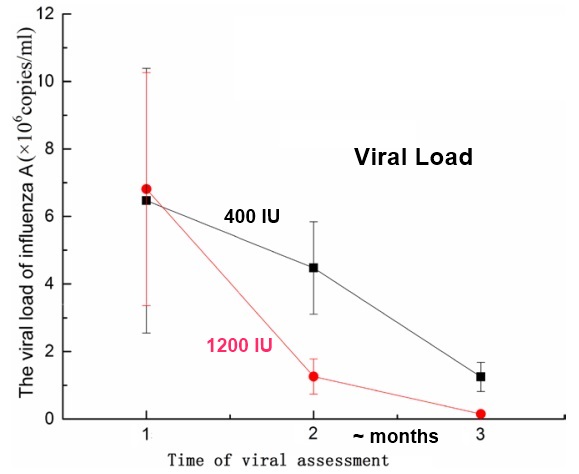Half the risk of Influenza -A in infants taking 1200 IU of vitamin D for 4 months – RCT
Preventive Effects of Vitamin D on Seasonal Influenza A in Infants: A Multicenter, Randomized, Open, Controlled Clinical Trial.
Pediatr Infect Dis J. 2018 Jan 8. doi: 10.1097/INF.0000000000001890.
📄 Download the PDF from Vitamin D Life
Reduced Fever

Note:Flu lasted about half as long for those with vitamin D
Reduced Wheezing

Reduced Viral load after 2 months in those going to hospital with a fever
This does not indicate the reduced number of children who did not get a fever due to the 1200 IU of vitamin D

Zhou J1, Du J1, Huang L2, Wang Y3, Shi Y3, Lin H2.
1 Department Of Pediatrics, The First People's Hospital Of Yongkang, China.
2 Dept Of Pediatrics, The Second Affiliated Hospital And Yuying Children's Hospital Of Wenzhou Medical U., Wenzhou, China.
3 Department Of Pediatrics, Jinhua People's Hospital, Jinhua, China.
OBJECTIVES:
This study aimed to evaluate the clinical efficacy and safety of vitamin D for preventing influenza A in 400 infants in a multicenter, randomized, open, controlled clinical trial.
METHODS:
The infants were randomized into low-dose and high-dose vitamin D groups, and serum calcium, inorganic phosphorus and 25-hydroxyvitamin D levels were detected thrice in 4 months. Infants infected with influenza A were monitored for symptoms including fever, cough, and wheezing. Pathogen levels and safety of vitamin D treatment were also evaluated.
RESULTS:
Of 121 cases in total, 78 and 43 cases of influenza A infection occurred in the low-dose and high-dose vitamin D groups, respectively. There was a significant difference between the groups (χ = 14.6324, P = 0.0001). Among the cases of influenza infection, the median durations for fever, cough, and wheezing were shorter in the high-dose vitamin D group than in the low-dose vitamin D group. The viral loads showed a downward trend in both groups, and were significantly different between the groups at the second and third detections. Additionally, the incidences of adverse events and severe adverse events were very low and not significantly different between the two groups.
CONCLUSION:
High-dose vitamin D (1200 IU) is suitable for the prevention of seasonal influenza as evidenced by rapid relief from symptoms, rapid decrease in viral loads, and disease recovery. In addition, high-dose vitamin D is probably safe for infants.
Title change made March 2021 caused the visitor count to reset.
There have actually been visitors to this page since it was originally made
